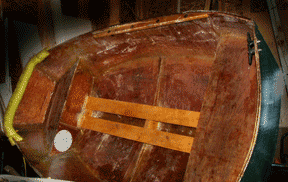When the mast came down this fall I discovered that about half the strands of the rear stay had broken at the top! That starts to look dangerous. So just a few days ago I took the old rigging in for an estimate to replace it…up around $300 for two cables with swagged ends and turnbuckles. I’m going to two lines to the mast top from the rear instead of the inverted “Y” that was in place…I want redundancy on all four sides of the mast.
Pondering the price, since I had already bought stainless cable last year, I decided to do my own, using galvanized turnbuckles and wire clips instead of swagged fittings. The total cost is about $30 on top of whatever I spent for the wire. Aside from spending well under $100, I have the capability to adjust the length by changing the size of the loops on the ends when I undo the wire clips. I had been struggling with a wrong length since I rebuilt the mast…it must be a couple of inches shorter than it was.
Buehler’s Backyard Boatbuilding is the name of a book which promotes using just the sort of rigging I’m going to try. He argues that the galvanized wire shows rust long before it weakens while stainless can hide the hairline fractures until they let go. There is no hurry, however. It just snowed for the first noticeable daytime amount. I don’t think sailing is in vogue at the moment.

